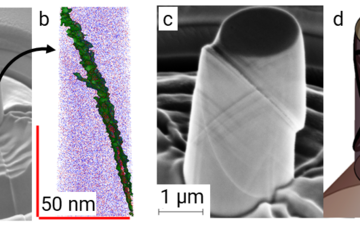All genres
1301.
Talk
Ab initio Thermodynamik in der Materialwissenschaft: Status und Perspektiven. Fraunhofer Institut für Werkstoffmechanik Freiburg, Kolloquium, Freiburg, Germany (2007)
1302.
Talk
Ab initio determination of symmetry-reduced structures by a soft-phonon analysis in Ni_{2}MnGa. Spring meeting of the German Physical Society (DPG), Regensburg, Germany (2007)
1303.
Talk
Ab initio prediction of structural and thermodynamic properties of magnetic shape memory alloys. Focus meeting of the SPP 1239: Fundamentals of the Magnetic Shape Memory Effect: Materials properties & simulations, Schloss Ringberg, Germany (2007)
1304.
Talk
Ab-initio Studies on Alloy Formation in Diluted Nitrides. Workshop on Nitride Based Nanostructures, Berlin, Germany (2007)
1305.
Talk
Implementation and application of a multi-scale approach to electronic properties of group III-nitride based semiconductor nanostructures. Workshop on Nitride Based Nanostructures, Berlin, Germany (2007)
1306.
Talk
Ab initio prediction of structural and thermodynamic properties of metals. Seminar Abt. Jansen, MPI für Festkörperforschung, Stuttgart, Germany (2007)
1307.
Talk
Ab initio basiertes Materialdesign auf dem Computer. Hahn-Meitner-Institut Berlin, Kolloquium, Berlin, Germany (2007)
1308.
Talk
A k.p approach to electronic states and Coulomb interaction in semiconductor quantum dots. Forschergruppentreffen Uni Bremen, Bremen, Germany (2007)
1309.
Talk
Ab initio based Multiscale Growth and Doping Simulations of Group-III Nitrides. UK Nitrides Consortium Meeting, Cambridge, UK (2007)
1310.
Talk
From ab initio to materials properties: Accuracy and error bars of DFT thermodynamics. MMM Workshop, Barcelona, Spain (2007)
1311.
Talk
Ab initio prediction of structural and thermodynamic properties of metals. International Max-Planck Workshop on Multiscale Materials Modeling of Condensed Matter, Sant Feliu de Guixols, Spain (2007)
1312.
Talk
Anomalous equilibrium volume change of magnetic Fe–Al crystals. Materials Research Society fall meeting, Boston, MA, USA (2006)
1313.
Talk
Bottom up design of novel Titanium-based biomaterials through the combination of ab-initio simulations and experimental methods. Materials Research Society fall meeting, Boston, MA, USA (2006)
1314.
Talk
Ab initio modellation of crystal growth. Polkom-Workshop, Dresden, Germany (2006)
1315.
Talk
Tailoring the N-solubility in InGaAs-alloys by surface engineering: Applications and limits. 1. Harzer Ab initio Workshop, Clausthal, Germany (2006)
1316.
Talk
Ab initio study of human-bone-matched titanium alloys. 1. Harzer Ab initio Workshop, Clausthal-Zellerfeld, Germany (2006)
1317.
Talk
Vibrational modes and thermodynamic properties of the secondary structure of proteins. 1. Harzer Ab initio Workshop, Clausthal (2006)
1318.
Talk
Exact exchange within Kohn-Sham formalism. Standard and variational approach. 1. Harzer Ab initio Workshop, Clausthal-Zellerfeld (2006)
1319.
Talk
Ab initio description of grain boundaries and diffusion processes. Arbeitstreffen der Helmholtz-Allianz „HYPER“,, Darmstadt (2006)
1320.
Talk
Variation of empirical potentials using ab initio methods. Arbeitstreffen der Helmholtz-Allianz „HYPER“, Darmstadt (2006)











